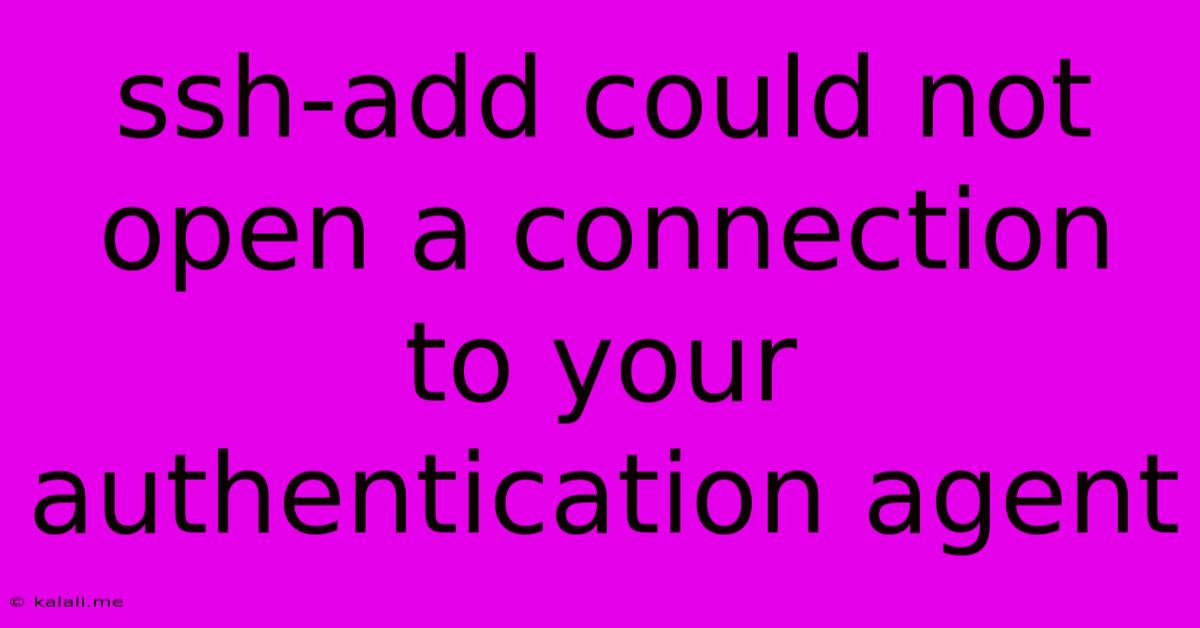Ssh-add Could Not Open A Connection To Your Authentication Agent
Kalali
Jun 04, 2025 · 3 min read

Table of Contents
SSH-Add Could Not Open a Connection to Your Authentication Agent: Troubleshooting Guide
This frustrating error message, "ssh-add: Could not open a connection to your authentication agent," pops up when your SSH client (like OpenSSH) can't communicate with the authentication agent responsible for securely storing your SSH keys. This prevents you from adding your SSH keys and using them for passwordless logins. This article will guide you through troubleshooting this common issue, offering solutions for various operating systems and scenarios.
Understanding the Problem:
The SSH agent (usually ssh-agent) acts as a secure intermediary between your SSH client and your private keys. It keeps your keys in memory, encrypted, so you don't need to repeatedly type your passphrase. When ssh-add fails, it means this connection is broken, possibly due to the agent not running, incorrect configuration, or permission issues.
Troubleshooting Steps:
Here's a breakdown of steps to resolve the "ssh-add: Could not open a connection to your authentication agent" error:
1. Check if the SSH Agent is Running:
-
Linux/macOS: Open a terminal and run
ps aux | grep ssh-agent. If you don't see anyssh-agentprocesses running, the agent isn't active. -
Windows: If you're using a Windows SSH client, check your client's documentation for how to verify the agent's status. Many Windows SSH clients handle agent management differently.
2. Start the SSH Agent:
If the agent isn't running, start it. The exact command varies slightly by operating system:
-
Linux/macOS:
- Manually Starting:
eval $(ssh-agent -s)This command starts the agent and sets the necessary environment variables. - Using a systemd service (Some Linux distros): This approach ensures the agent starts automatically upon login. Consult your distribution's documentation for details.
- Manually Starting:
-
Windows: Refer to your specific SSH client's documentation.
3. Add Your SSH Key:
After starting the agent, try adding your key again: ssh-add ~/.ssh/id_rsa (replace id_rsa with your private key filename).
4. Check for Environment Variable Conflicts:
Sometimes, conflicting environment variables can interfere with the SSH agent's functionality. Check your .bashrc, .bash_profile, .zshrc (depending on your shell) for any custom SSH-related settings that might be causing the problem. Temporarily comment them out to test.
5. Permissions and Ownership:
Ensure your SSH directory and key files have the correct permissions. The ~/.ssh directory should be owned by you (e.g., user:user), and the permissions should be 700 (only you can access it). Private keys (id_rsa, id_ed25519, etc.) should have 600 permissions (only you can read and write). Use the chmod command to correct these if necessary. For example: chmod 700 ~/.ssh and chmod 600 ~/.ssh/id_rsa.
6. Firewall Interference:
In rare cases, a firewall might be blocking communication between your SSH client and the agent. Temporarily disabling your firewall (for testing purposes only!) can help determine if this is the cause. Remember to re-enable your firewall afterward.
7. Restart your System:
Sometimes, a simple system restart can clear up temporary glitches or inconsistencies.
8. Check for SSH Agent Forwarding Issues (Advanced):
If you're accessing a remote server and encountering this error, ensure SSH agent forwarding is properly configured.
9. Consider Re-generating Your SSH Keys:
As a last resort, if all else fails, consider generating a new pair of SSH keys. This eliminates any potential corruption in your existing keys.
Preventing Future Issues:
- Use a desktop GUI application for SSH key management: Applications like GitKraken or SourceTree often integrate seamless key management.
- Configure your agent to start automatically on login: This ensures it's always available when you need it. Consult your OS or shell configuration for details.
By systematically working through these steps, you should be able to resolve the "ssh-add: Could not open a connection to your authentication agent" error and regain passwordless SSH access. Remember to always prioritize security best practices when managing your SSH keys.
Latest Posts
Latest Posts
-
How Do I Check My Likes On Facebook
Jun 06, 2025
-
Garage Door Wont Close Unless I Hold The Button
Jun 06, 2025
-
How Long Do Cookies Take To Cool
Jun 06, 2025
-
How To Say You Are Welcome In French
Jun 06, 2025
-
Where To Recharge A Fire Extinguisher
Jun 06, 2025
Related Post
Thank you for visiting our website which covers about Ssh-add Could Not Open A Connection To Your Authentication Agent . We hope the information provided has been useful to you. Feel free to contact us if you have any questions or need further assistance. See you next time and don't miss to bookmark.